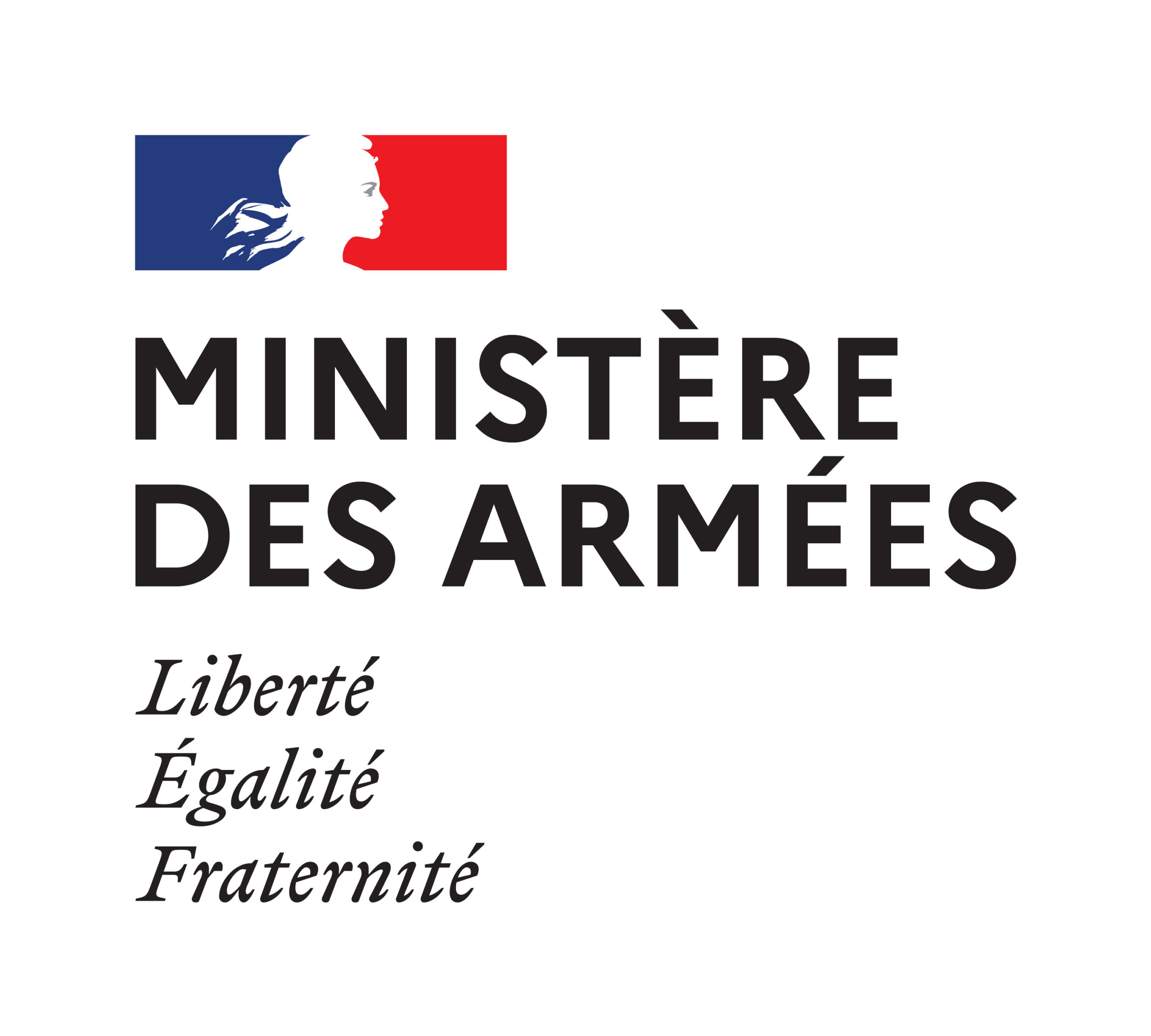BERGEN-BELSEN
Opening : June 1940
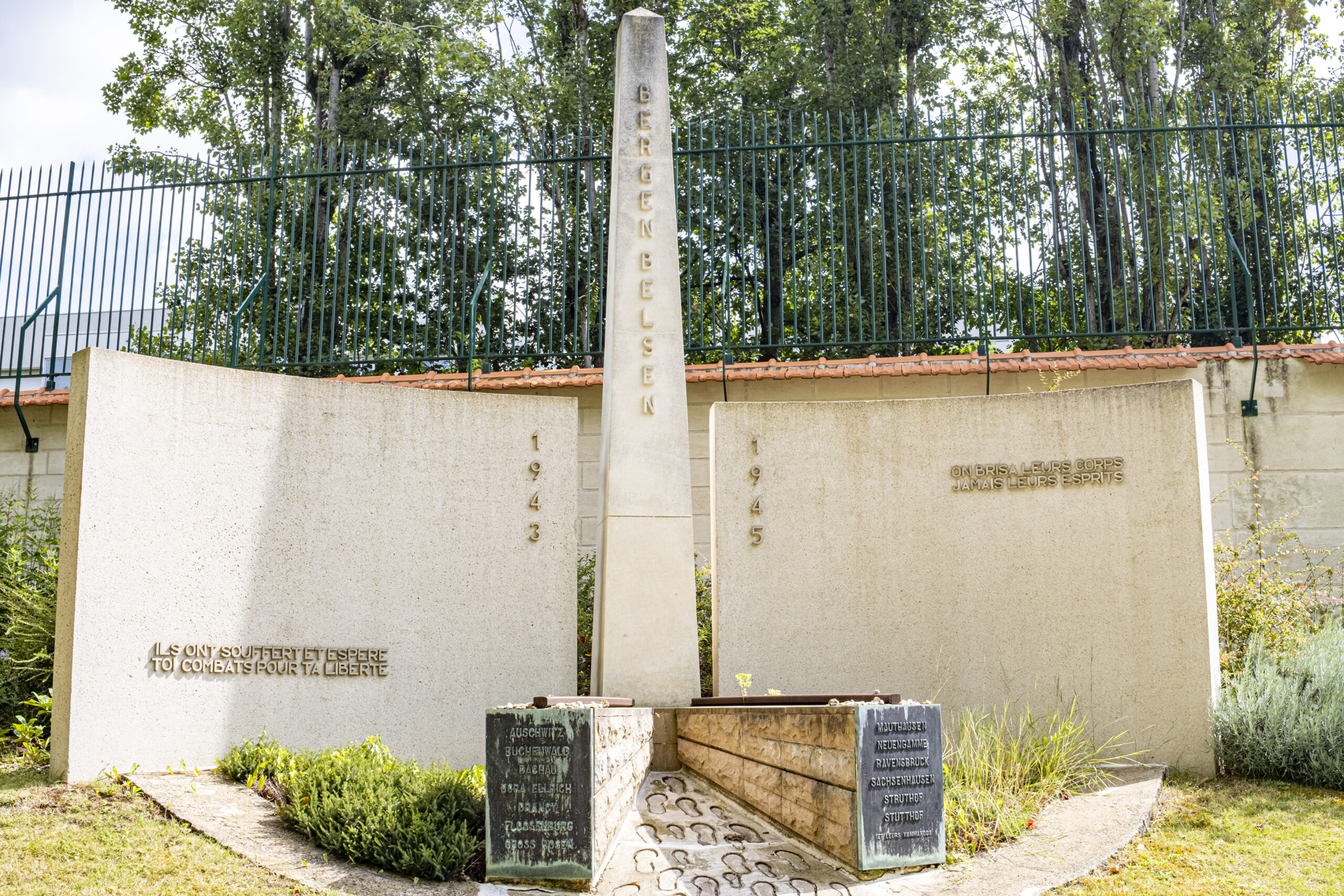
© Vincent Gerbet
Monument description
Inaugurated on March 23, 1994, by the architect Guillaume d’Astorg, this monument in cut stone and concrete recalls the one that stands on the site of the Bergen-Belsen camp, in the middle of a heath of heather.
The wall holds the eye of the visitor and directs him to the central fracture that opens on darkness and nothingness but reveals the obelisk of hope pointed to the sky.
The period rails laid on walls and footprints on the ground recall the evacuations of deportees from other camps in a northbound direction towards Bergen-Belsen, either by train or during the «death marches».
The appearance of the obelisk facing the sky opens the door of hope.
While the greatest number of victims of this camp were Jewish, the monument avoids any specific reference to pay a general tribute to all the victims.
Are listed:
– on the obelisk: Bergen-Belsen
– on the wall on either side of the obelisk: « 1943 – 1945 »
– on the wall, bottom left :

– on the upper right wall :
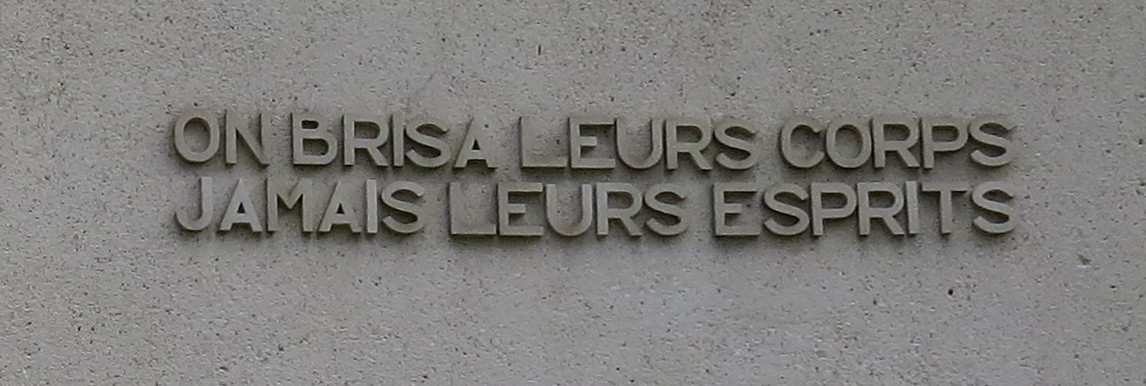
– on the bronze plates in front, at the foot of the obelisk, the names of the camps from which the deportees were evacuated to Bergen-Belsen :
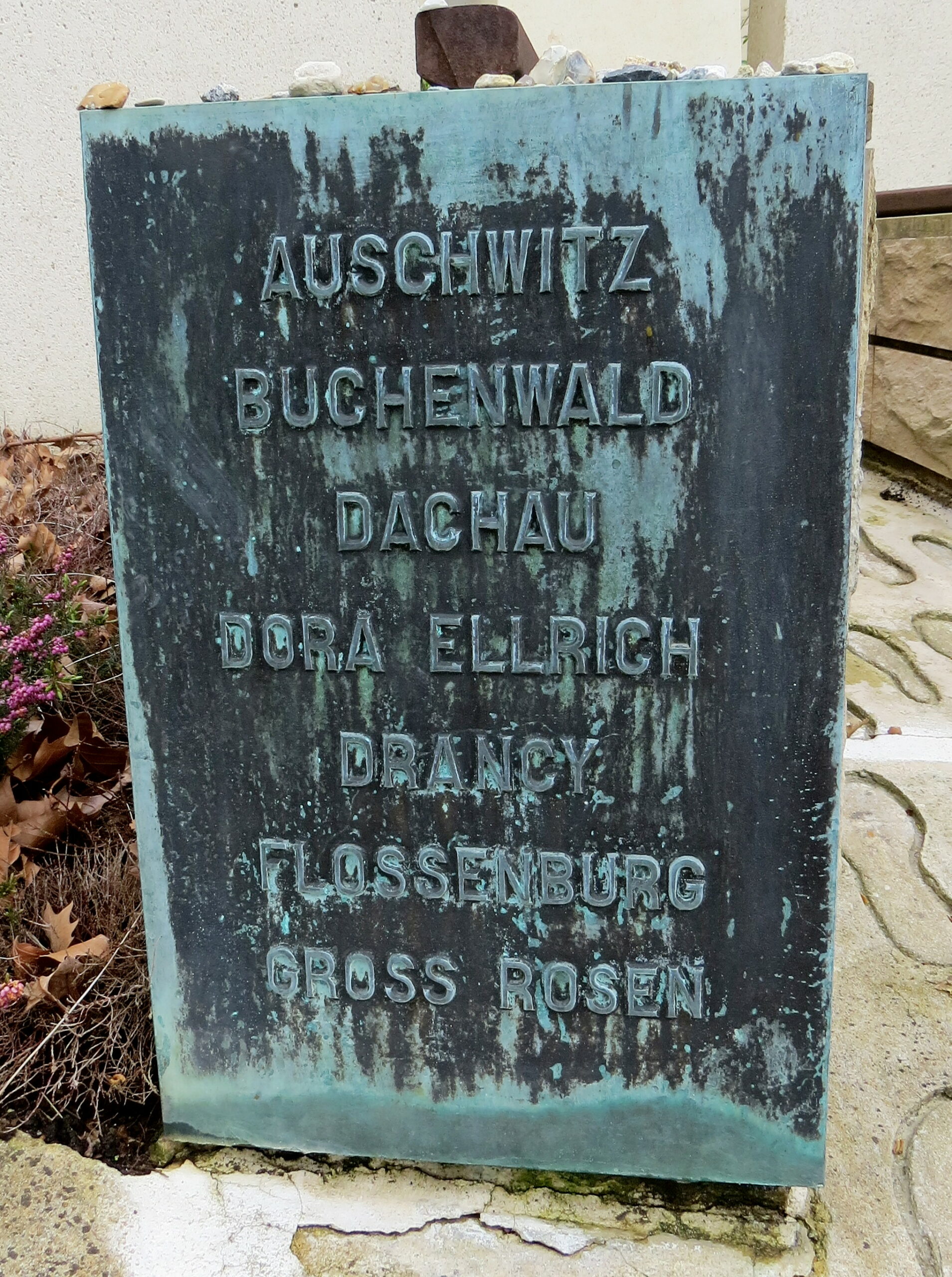
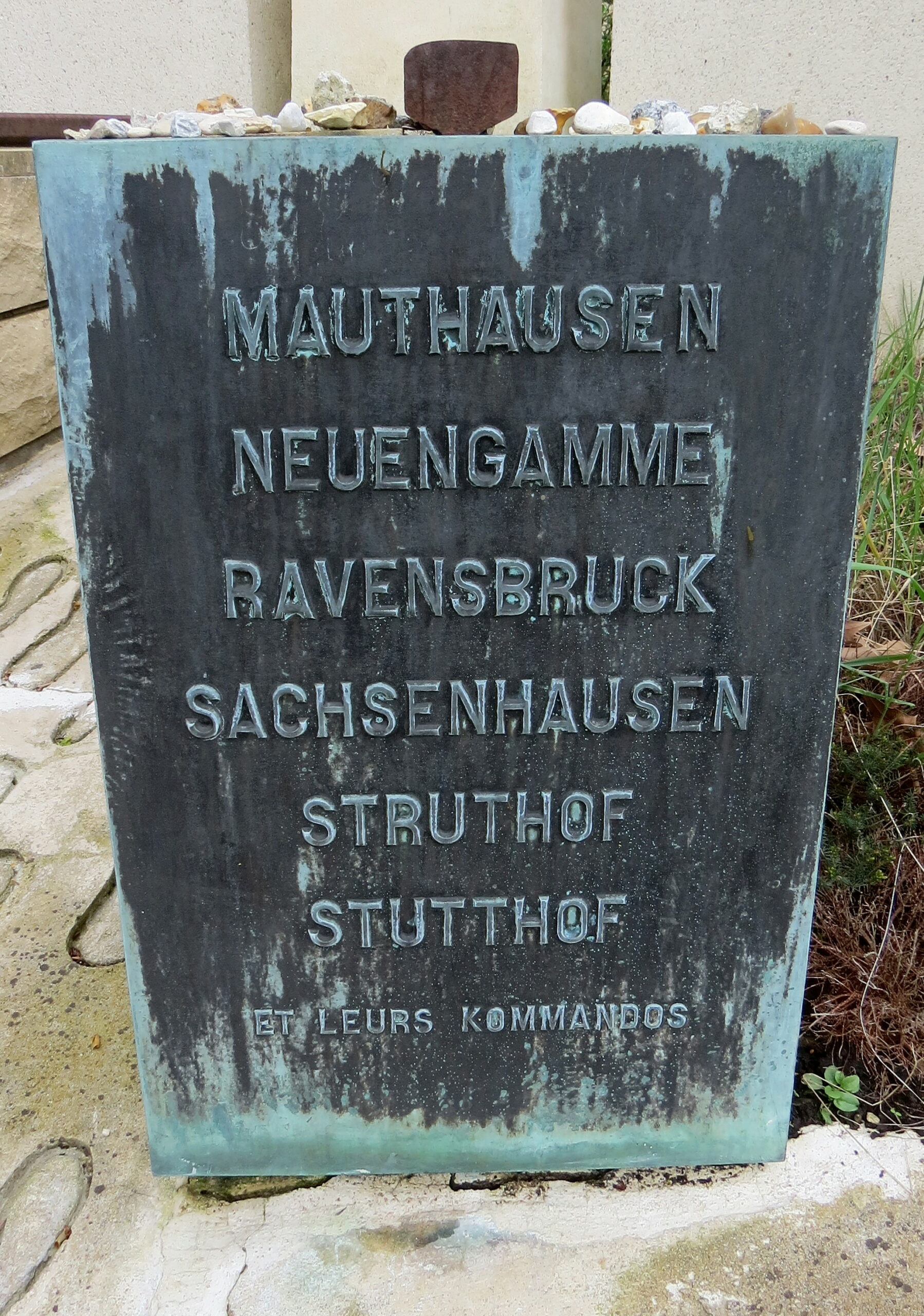
©AFMD 75
Bergen-Belsen camp
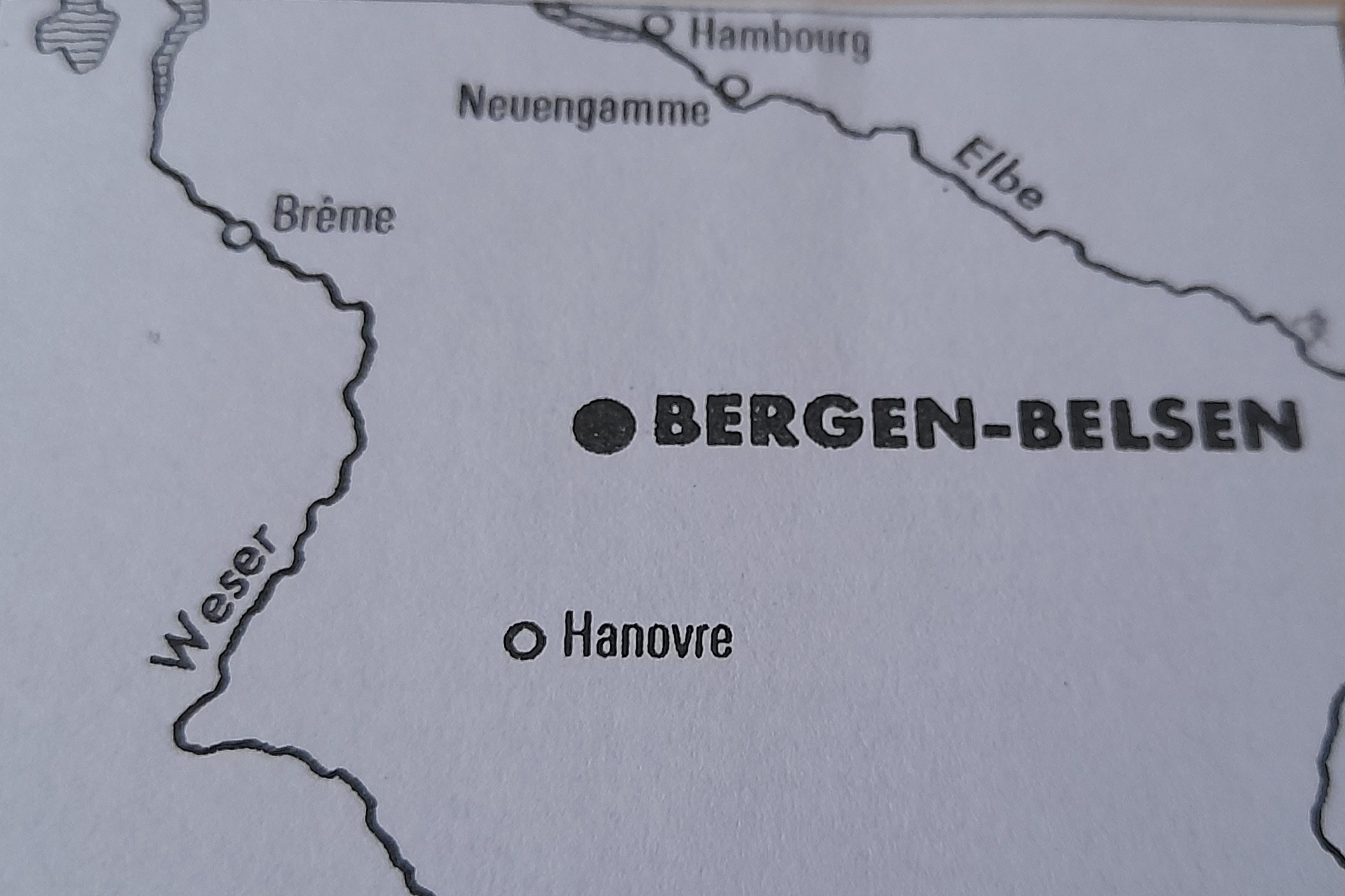
© FNDIRP
Bergen-Belsen is located in Lower Saxony, 80 km north of Hanover and 60 km south of Hamburg, southwest of the city of Bergen, near the town of Belsen.
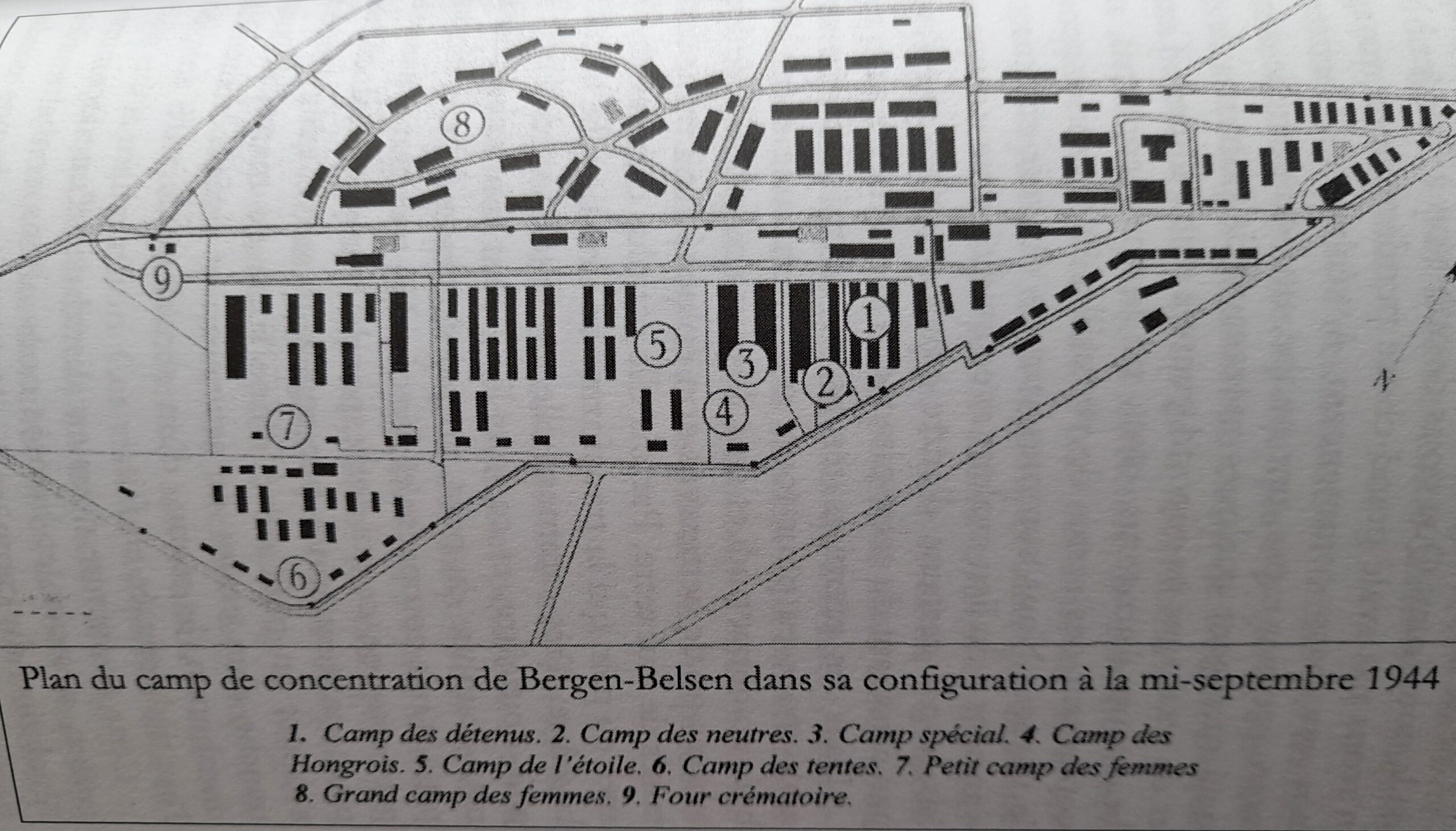
1 – The prison camp: a real death trap, inmates who are sick or unable to work arrive from other camps. Some are sometimes killed by injections.
2 – The neutral camp: for Jews from neutral countries (Spain, Portugal, Argentina, Turkey. The existence there was less difficult than in the other camps until March 1945; the detainees were not assigned to the working kommandos.
3 – The special camp: in mid-1943, several thousand Polish Jews were deported there. Most had provisional identity documents from South American states. They were not sent in Kommando and were kept away from other detainees because they had witnessed the atrocities perpetrated in Poland by the SS.
4 – The camp of Hungarian Jews: established in July 1944 for the 1,685 Hungarian Jews being the subject of talks between Himmler and some foreign Jewish organizations.
It was to negotiate their exchange for ransom in cash and goods.
These Hungarians were in civilian clothes and wore the yellow star. They were not required to work. 318 of them were transferred to Switzerland.
5 – Star Camp or Exchange Camp
6 – The tent camp: in early August 1944, it was used for the transit of many convoys of women from Poland. In late October-early November 1944, 8,000 women evacuated from Auschwitz-Birkenau were detained there.
7 – The small women’s camp: from August 1944, women were detained there, coming from Auschwitz. Among them, Anne Frank and her sister Margot both died of typhus in March 1945.
8 – The great women’s camp: from the autumn of 1944, prisoners arrived in large numbers of Kommandos close to the front. In January 1945, the former Lazaret Hospital became the great women’s camp.
The camp was built for prisoners during the First World War.
In June 1940, the Wehrmacht used this barracks camp to house 600 French and Belgian prisoners of war. It was Stalag XI B.
In May-June 1941, the Wehrmacht commissioned another Stalag, the Stalag XIC (311) for Soviet prisoners of war who arrived there in July in a first convoy of 2,000 prisoners. In August, the Gestapo made a «selection»: 500 of them, Jews or political leaders, were transported to the Sachsenhausen camp and murdered.
In the fall, more than 21,000 Soviets will be parked there. 90% will die because of the terrible conditions: not enough huts, cold, hunger, malnutrition, lack of hygiene, diseases…
They will be replaced by French, Italian and Polish soldiers.
In April 1943, the Reich Foreign Office devised a plan whereby 30,000 Jewish prisoners could be used as hostages for possible exchanges with German prisoners interned abroad.
At the end of 1944, at least 14,600 Jews from Hungary and the Netherlands were detained there.
In October 1943, 1,800 Polish Jews were sent to Birkenau to be murdered.
From March 1944, there is still a reserve of hostages but the camp changes, it becomes the place of arrival of the convoys of evacuation of the whole Reich following the advance of the allied armies.
At the end of June 1944, a convoy of 222 Jews left the exchange camp for Palestine. By April 1945, approximately 2,560 exchange prisoners will be released.
In May and July 1944, two groups of women and children of French and Jewish prisoners of war arrived from the Drancy camp. They wear their own clothes with the yellow star sewn on. The women go to work in workshops.
From August 1944, a new sub-camp for women was created. Thousands arrive from Auschwitz to work in other camps as well as in three Bergen-Belsen camps. In October and November, after the repression of the Warsaw uprising, 1,000 women soldiers and officers of the Polish army arrived in the camp.
From December 1944, as part of the evacuation of the camps near the front, 85,000 detainees will be transferred to Bergen-Belsen.
In early April 1945, 3 trains of about 6,700 prisoners left the exchange camp for the Terezin ghetto (Theresienstadt). In 2 of these trains are deportees from Drancy. Some were liberated near Magdeburg on 13 April by American troops, others near Tröbitz on 23 April by Soviet troops.
A plaque in Tröbitz pays tribute to the 160 Jewish victims of the «Lost Train» from Bergen-Belsen because the Allied bombing prevented him from going to Theresienstadt.
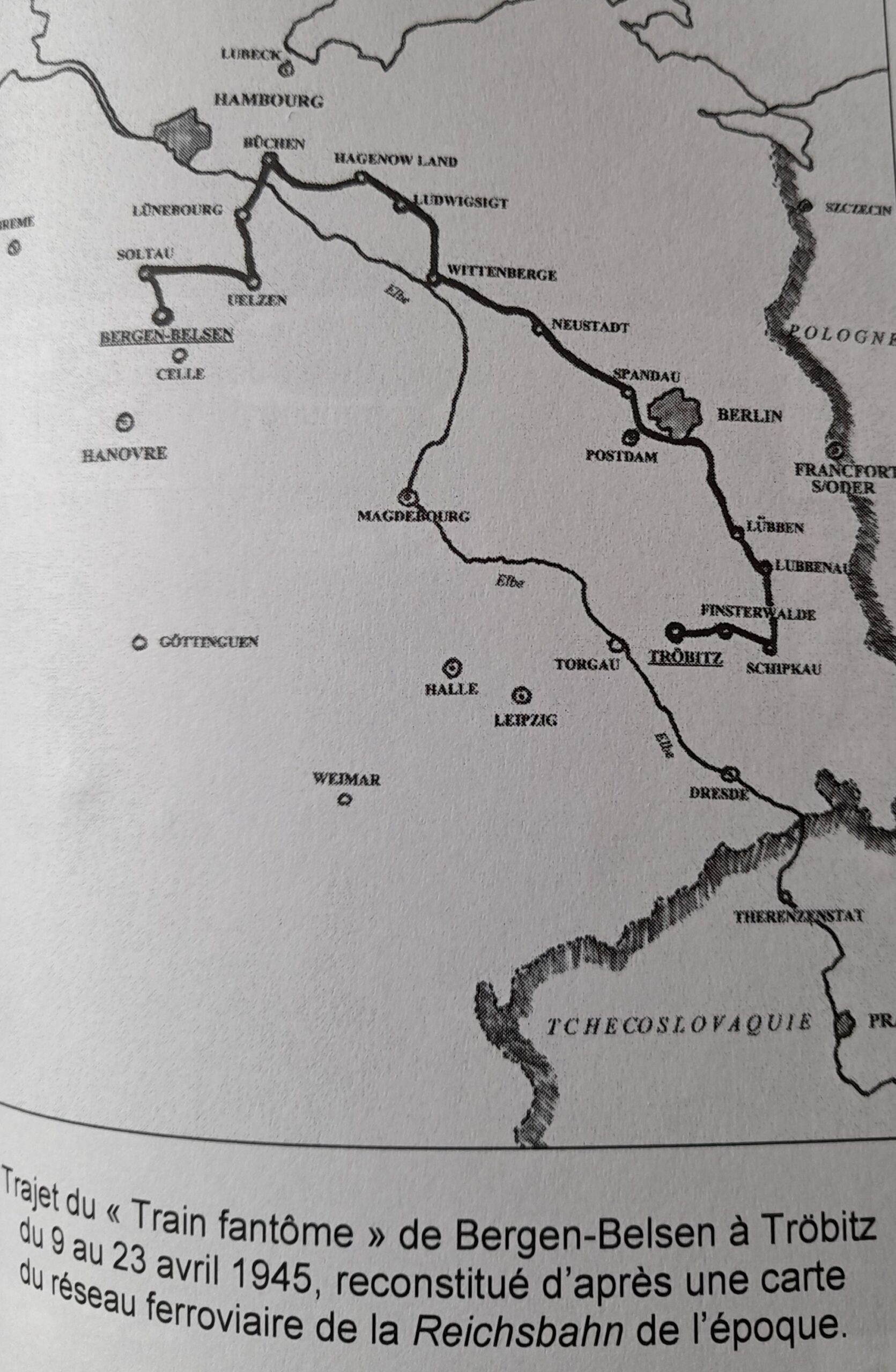
The camp, overcrowded, turns into a death row in the face of the expansion of epidemics such as typhus. Thousands of corpses lie on the ground and are piled up in mass graves.
At the Bergen-Belsen prison camp, at least 19,700 people died.
At the Bergen-Belsen concentration camp, at least 37,000 women, men and children died, and 13,000 died shortly after their release.
Besides Margot and Anne Frank (whose «Le Journal» was published in Amsterdam in 1947) and Hélène Berr (whose newspaper was published in 2008), two French MPs-mayors Augustin Malroux and Claude Jordery, among the 80 parliamentarians who refused full powers to Pétain, died in Bergen-Belsen.
On April 15, 1945, British troops released about 53,000 prisoners who tried to survive among the bodies. They will receive “Displaced persons” (DP) status.
They bury more than 20,000 bodies in mass graves and destroy most of the wooden huts with flamethrowers to prevent the spread of epidemics.
The first commander is the SS Adolf Haas replaced in December 1944 by Josef Kramer (previously commander of Natzweiller then Birkenau), nicknamed the beast of Bergen by the detainees.
At the Bergen trial, initiated by the British Military Court, he was found guilty of war crimes, responsible for the death of thousands of mostly Jewish deportees and hanged on 13 December 1945.
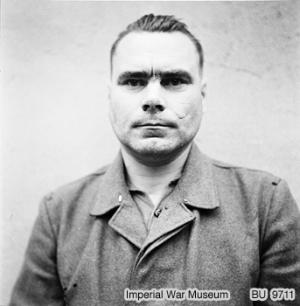
Joseph Kramer (1945)
Sources
– Amicale française de Bergen-Belsen:- Friends and Enthusiasts of Père Lachaise:
– Fondation de la mémoire de la Déportation (FMD), revue Mémoire vivante, n°47, dossier Bergen-Belsen, 2005
– Fondation de la mémoire de la Déportation (FMD), revue Mémoire vivante, no. 66, dossier on the fate of families of Jewish prisoners of war in France, 2010
– FONTAINE Thomas, Deportation and Genocide – The Impossible Forgetting, FNDIRP, ed. Tallandier, coll. Contemporary, 2009
– SAUREL Jacques, De Drancy à Bergen-Belsen 1944-1945 – Collected memories of a deported child, The manuscript Eds, Coll. Testimonies of the Holocaust, 2006
– « The Lost Train: Bergen-Belsen to Tröbitz »:
https://www.jewishgen.org/databases/Holocaust/0170_lost_train.html
– Bergen-Belsen Memorial in Germany: http://bergen-belsen.stiftung-ng.de
– https://en.wikipedia.org/wiki/Bergen-Belsen
Bergen-Belsen
Opening : June 1940

© Vincent Gerbet
Monument description
Inaugurated on March 23, 1994, by the architect Guillaume d’Astorg, this monument in cut stone and concrete recalls the one that stands on the site of the Bergen-Belsen camp, in the middle of a heath of heather.
The wall holds the eye of the visitor and directs him to the central fracture that opens on darkness and nothingness but reveals the obelisk of hope pointed to the sky.
The period rails laid on walls and footprints on the ground recall the evacuations of deportees from other camps in a northbound direction towards Bergen-Belsen, either by train or during the «death marches».
The appearance of the obelisk facing the sky opens the door of hope.
While the greatest number of victims of this camp were Jewish, the monument avoids any specific reference to pay a general tribute to all the victims.
Are listed:
– on the obelisk: Bergen-Belsen
– on the wall on either side of the obelisk: « 1943 – 1945 »
– on the wall, bottom left :

– on the upper right wall :

– on the bronze plates in front, at the foot of the obelisk, the names of the camps from which the deportees were evacuated to Bergen-Belsen :


©AFMD 75
Bergen-Belsen camp

© FNDIRP
Bergen-Belsen is located in Lower Saxony, 80 km north of Hanover and 60 km south of Hamburg, southwest of the city of Bergen, near the town of Belsen.

1 – The prison camp: a real death trap, inmates who are sick or unable to work arrive from other camps. Some are sometimes killed by injections.
2 – The neutral camp: for Jews from neutral countries (Spain, Portugal, Argentina, Turkey. The existence there was less difficult than in the other camps until March 1945; the detainees were not assigned to the working kommandos.
3 – The special camp: in mid-1943, several thousand Polish Jews were deported there. Most had provisional identity documents from South American states. They were not sent in Kommando and were kept away from other detainees because they had witnessed the atrocities perpetrated in Poland by the SS.
4 – The camp of Hungarian Jews: established in July 1944 for the 1,685 Hungarian Jews being the subject of talks between Himmler and some foreign Jewish organizations.
It was to negotiate their exchange for ransom in cash and goods.
These Hungarians were in civilian clothes and wore the yellow star. They were not required to work. 318 of them were transferred to Switzerland.
5 – Star Camp or Exchange Camp
6 – The tent camp: in early August 1944, it was used for the transit of many convoys of women from Poland. In late October-early November 1944, 8,000 women evacuated from Auschwitz-Birkenau were detained there.
7 – The small women’s camp: from August 1944, women were detained there, coming from Auschwitz. Among them, Anne Frank and her sister Margot both died of typhus in March 1945.
8 – The great women’s camp: from the autumn of 1944, prisoners arrived in large numbers of Kommandos close to the front. In January 1945, the former Lazaret Hospital became the great women’s camp.
The camp was built for prisoners during the First World War.
In June 1940, the Wehrmacht used this barracks camp to house 600 French and Belgian prisoners of war. It was Stalag XI B.
In May-June 1941, the Wehrmacht commissioned another Stalag, the Stalag XIC (311) for Soviet prisoners of war who arrived there in July in a first convoy of 2,000 prisoners. In August, the Gestapo made a «selection»: 500 of them, Jews or political leaders, were transported to the Sachsenhausen camp and murdered.
In the fall, more than 21,000 Soviets will be parked there. 90% will die because of the terrible conditions: not enough huts, cold, hunger, malnutrition, lack of hygiene, diseases…
They will be replaced by French, Italian and Polish soldiers.
In April 1943, the Reich Foreign Office devised a plan whereby 30,000 Jewish prisoners could be used as hostages for possible exchanges with German prisoners interned abroad.
At the end of 1944, at least 14,600 Jews from Hungary and the Netherlands were detained there.
In October 1943, 1,800 Polish Jews were sent to Birkenau to be murdered.
From March 1944, there is still a reserve of hostages but the camp changes, it becomes the place of arrival of the convoys of evacuation of the whole Reich following the advance of the allied armies.
At the end of June 1944, a convoy of 222 Jews left the exchange camp for Palestine. By April 1945, approximately 2,560 exchange prisoners will be released.
In May and July 1944, two groups of women and children of French and Jewish prisoners of war arrived from the Drancy camp. They wear their own clothes with the yellow star sewn on. The women go to work in workshops.
From August 1944, a new sub-camp for women was created. Thousands arrive from Auschwitz to work in other camps as well as in three Bergen-Belsen camps. In October and November, after the repression of the Warsaw uprising, 1,000 women soldiers and officers of the Polish army arrived in the camp.
From December 1944, as part of the evacuation of the camps near the front, 85,000 detainees will be transferred to Bergen-Belsen.
In early April 1945, 3 trains of about 6,700 prisoners left the exchange camp for the Terezin ghetto (Theresienstadt). In 2 of these trains are deportees from Drancy. Some were liberated near Magdeburg on 13 April by American troops, others near Tröbitz on 23 April by Soviet troops.
A plaque in Tröbitz pays tribute to the 160 Jewish victims of the «Lost Train» from Bergen-Belsen because the Allied bombing prevented him from going to Theresienstadt.

The camp, overcrowded, turns into a death row in the face of the expansion of epidemics such as typhus. Thousands of corpses lie on the ground and are piled up in mass graves.
At the Bergen-Belsen prison camp, at least 19,700 people died.
At the Bergen-Belsen concentration camp, at least 37,000 women, men and children died, and 13,000 died shortly after their release.
Besides Margot and Anne Frank (whose «Le Journal» was published in Amsterdam in 1947) and Hélène Berr (whose newspaper was published in 2008), two French MPs-mayors Augustin Malroux and Claude Jordery, among the 80 parliamentarians who refused full powers to Pétain, died in Bergen-Belsen.
On April 15, 1945, British troops released about 53,000 prisoners who tried to survive among the bodies. They will receive “Displaced persons” (DP) status.
They bury more than 20,000 bodies in mass graves and destroy most of the wooden huts with flamethrowers to prevent the spread of epidemics.
The first commander is the SS Adolf Haas replaced in December 1944 by Josef Kramer (previously commander of Natzweiller then Birkenau), nicknamed the beast of Bergen by the detainees.
At the Bergen trial, initiated by the British Military Court, he was found guilty of war crimes, responsible for the death of thousands of mostly Jewish deportees and hanged on 13 December 1945.

Joseph Kramer (1945)
Sources
– Amicale française de Bergen-Belsen:- Friends and Enthusiasts of Père Lachaise:
– Fondation de la mémoire de la Déportation (FMD), revue Mémoire vivante, n°47, dossier Bergen-Belsen, 2005
– Fondation de la mémoire de la Déportation (FMD), revue Mémoire vivante, no. 66, dossier on the fate of families of Jewish prisoners of war in France, 2010
– FONTAINE Thomas, Deportation and Genocide – The Impossible Forgetting, FNDIRP, ed. Tallandier, coll. Contemporary, 2009
– SAUREL Jacques, De Drancy à Bergen-Belsen 1944-1945 – Collected memories of a deported child, The manuscript Eds, Coll. Testimonies of the Holocaust, 2006
– « The Lost Train: Bergen-Belsen to Tröbitz »:
https://www.jewishgen.org/databases/Holocaust/0170_lost_train.html
– Bergen-Belsen Memorial in Germany: http://bergen-belsen.stiftung-ng.de
– https://en.wikipedia.org/wiki/Bergen-Belsen
Délégation de Paris des Amis de la Fondation
pour la Mémoire de la Déportation
31 Boulevard Saint-Germain 75005 Paris
Contact : afmd.dt75@gmail.com
©AFMD75




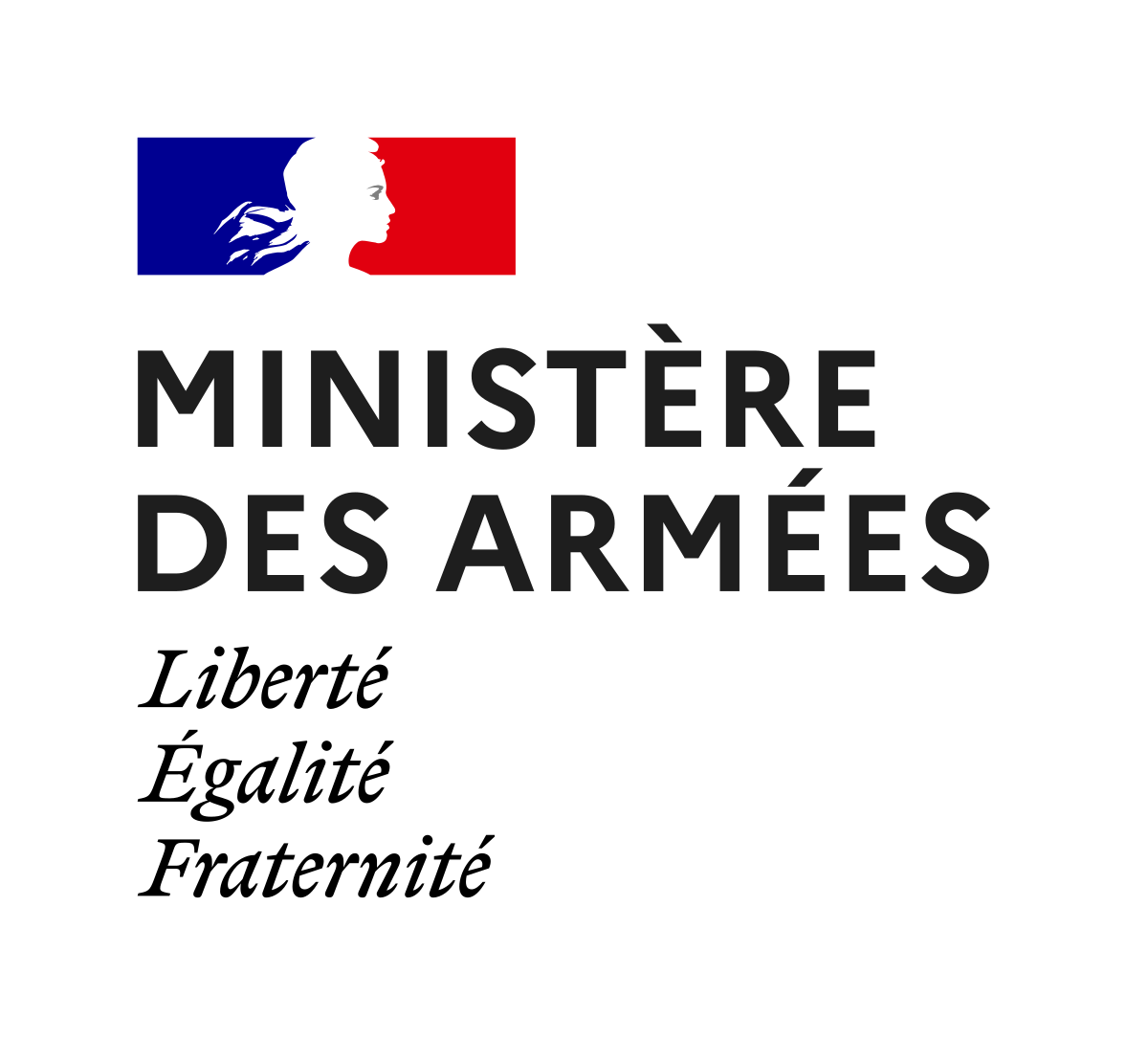

Délégation de Paris
des Amis de la Fondation
pour la Mémoire de la Déportation
31 Boulevard Saint-Germain
75005 Paris
Contact :
afmd75@gmail.com
©AFMD75
Délégation de Paris
des Amis de la Fondation
pour la Mémoire
de la Déportation
31 Boulevard Saint-Germain
75005 Paris
Contact
afmd75@gmail.com
©AFMD75



